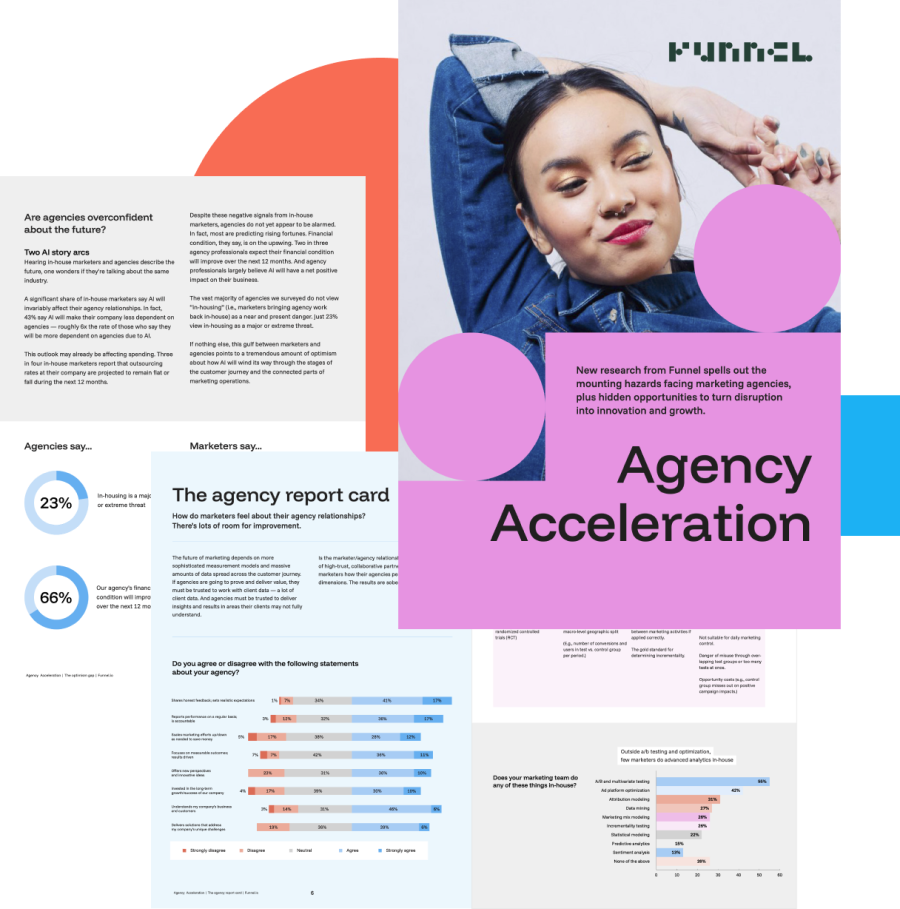-
 Written by Sean Dougherty
Written by Sean DoughertySenior Brand Creative at Funnel, Sean has more than 15 years of experience working in branding and advertising (both agency and client side). He's also a professional voice actor.
According to fresh research we conducted alongside Ravn Research, a whopping 75% of in-house marketers expect their spend on agencies to remain flat or fall over the next 12 months. Much of the freeze/shrink in spending is driven by new technologies and a perceived lack of value.
As many as 43% of marketers said that artificial intelligence will make them less dependent on their agencies. At the same time, only 40% of marketers surveyed said agencies are invested in their company's long-term growth and success.
While this may spell doom for middle-of-the-road agencies, the most successful shops will turn to a new source of differentiation: advanced analytics.
What are advanced analytics?
Advanced analytics refers to a set of sophisticated techniques and tools for analyzing complex (and large) data sets and surfacing actionable insights. This type of analysis goes beyond the typical reporting that many marketers and agencies are used to, which is exactly why it could be a new lifeblood for agencies that can provide the expertise.
For instance, advanced analytics aims to uncover patterns, predict future trends and deliver strategic guidance. This requires a unique skillset — one that many in-house teams can’t afford on a full-time basis.
Examples of advanced analytics techniques
Advanced analytics can take many forms, but the most common techniques include predictive analysis, prescriptive analysis, machine learning, natural language processing, data mining and some form of statistical modeling.
Predictive analysis
You can probably guess what this type of analysis entails. It uses large amounts of historical data to make predictions about future outcomes.
In the old days, some marketing strategists may have done this through estimation or general inference (often without any hard calculations or measurable results). Today, though, predictive analysis uses a variety of computer models to forecast which audience segments are most likely to convert, allowing agencies and marketers to adapt their campaigns and tactics ahead of time.
Prescriptive analysis
Once you have peered through the proverbial crystal ball via predictive analysis, prescriptive analysis suggests tangible actions for a marketing team or agency to take. For instance, your models may predict a sudden drop in overall consumer demand (due to seasonality, market uncertainty, etc.). Prescriptive analysis will then advise you to cut media spend or pivot your messaging to better speak to the market conditions of the moment.
Machine learning
This is the basis upon which AI works. Machine learning uses a combination of algorithms to ingest vast amounts of data and find patterns (both in a historical and future context) that can inform your other advanced analytics processes.
The great thing about machine learning is that you don’t need to build explicit code to achieve results. The machine, instead, develops its own inferences on a large scale.
Natural language processing
This technique allows marketers and agencies to analyze unstructured data at scale. Think of social media posts, customer reviews, etc. These data points don’t fit neatly into harder marketing metrics, making them difficult to normalize and surface insights.
With machine learning and AI, though, you can quickly analyze large amounts of this prose-based data to find trends in customer sentiment, brand perception and more.
Data mining
Data mining is a bit more straightforward. It involves discovering patterns and correlations in large data sets. This can be human- or machine-led (we recommend the latter).
Statistical modeling
This technique applies mathematical equations and analysis to analyze complex relationships within data. A great example is linear regression or marketing mix modeling.

Click the button below to download your copy of Agency Acceleration and learn how agencies need to position themselves for the future.
Schedule your free demo
How advanced analytics benefits everyone in marketing
Whether you’re on the client or agency side, advanced analytics really are the key to success today and tomorrow. Most marketing professionals have trouble just keeping track of all the platforms they operate on — let alone managing and making sense of the vast amount of data they generate.
You need tools and techniques that eliminate the need to work with that data manually. Through automation and machine-led analysis, marketers and agencies can focus on the juicer parts of their jobs.
Think of it this way, would you rather:
A) Spend days manually organizing and normalizing data in clunky spreadsheets.
Or
B) Have an advanced AI assistant ingest and analyze your data in minutes so that you can craft strategies to personalize your marketing outreach on a granular level, find ways to optimize your marketing spend and find new opportunities to test your messaging.
We would much prefer option B.
Why are advanced analytics so powerful for agencies
As we mentioned, many in-house marketing teams don’t have the resources to hire one, two or three data analysis experts or strategists. On top of that, these marketing teams are often producing at full capacity, with new marketing requests coming in every day.
This means advanced analytics provides huge opportunities for those agencies who can provide these services at a reduced rate compared to a full-time in-house hire. After all, agencies can offset this headcount cost by applying it across multiple accounts. Take it from Andrew Ford, vice president of data strategy and analytics at Wpromote.
“When you sign a retainer with our agency, you’re getting access to five or six domain experts in tagging, data engineering, reporting, analytics and data science” Andrew said. “We can bring all those things to bear for a much, much more compressed cost than you would have to pay to hire six different people. That’s because we can share resources across accounts. We help clients go from zero to 60 really quickly.”
Marketing teams need these services, but many are still not ramping up their capacity fast enough. According to our research, just 31% of marketers use machine learning and AI for advanced analysis.
The golden opportunity
In a world of overflowing data and greater competition, marketing teams desperately need the ability to perform advanced analysis to stay ahead. However, due to budget and time constraints, most teams simply can’t plan for or act on those needs.
In a market where clients are cutting costs and questioning agency value, agencies with advanced analytics capabilities have a unique opportunity to stand out and thrive.
Would you like to learn more about how advanced analytics can help marketing agencies of all sizes grow? Download our Agency Acceleration report to discover how agencies can solidify their positions as industry leaders. Moreover, gain valuable insights from in-house marketers about their expectations from agency partners."
-
 Written by Sean Dougherty
Written by Sean DoughertySenior Brand Creative at Funnel, Sean has more than 15 years of experience working in branding and advertising (both agency and client side). He's also a professional voice actor.
